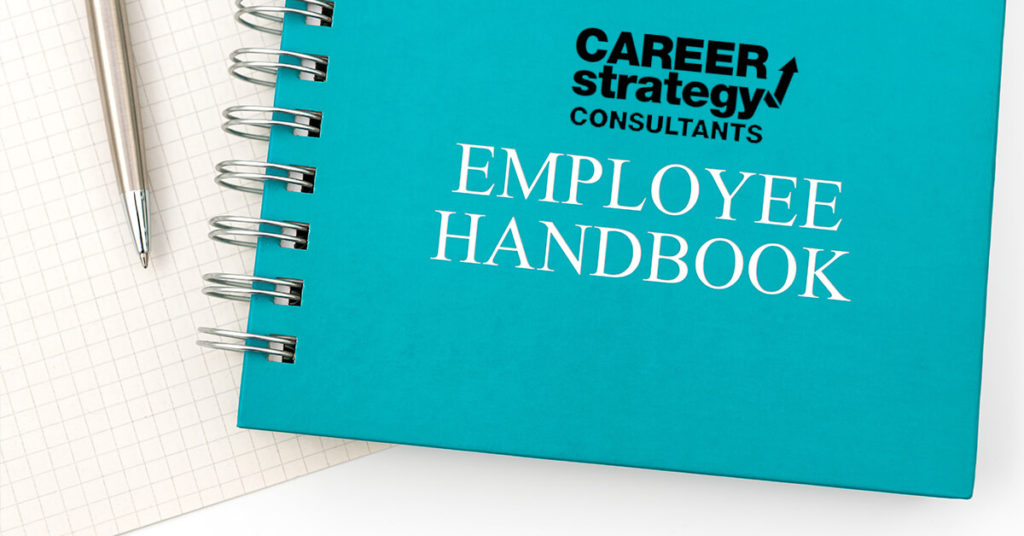What to Include in Your Employee Handbook


If you’re the type of business owner that wants to provide a safe and engaging work environment, it’s important that you follow through and create a handbook for your employees. While every business is different, employee handbooks typically include topics such as ethics or benefits. All in all, an employee handbook is a crucial tool for any business looking to make sure their staff knows proper behavior and how to avoid legal issues. This article will discuss what topics should be included in your own employment handbook based on what we’ve seen across nearly every industry.
Protecting Your Company From Liability
Employee handbooks are, by definition, written documents that attempt to convey information about your company’s policies and benefits to your staff in writing. Many employee handbooks also tackle the topic of the law. This includes reminders about your company’s obligations to its employees and how to handle any issues with employees or customers in a legal sense.
If you think your staff would be confused by this information, consider creating a separate handbook for each of your employees if necessary. Having one handbook is great for providing a general overview, but having multiple documents helps address specific topics that your employees may run into. In most cases, you’ll want to reference different laws from state-to-state, which again requires multiple documents.
It’s also important that you include all of your company’s policies in the employee handbook. The same piece of information should not be needed in multiple documents, which can cause confusion for employees. Every business is different, of course, but these are the topics that, by far, are most important for us to focus on at our own business. We hope they will help you improve yours as well! An employee handbook is an incredibly valuable tool for employers looking to maintain a safe and positive work environment for their staff.
Creating an Employee Handbook
Creating an employee handbook isn’t as difficult as many people think. Even with a team to help, creating an employee handbook is still a time-consuming process. If you’re looking to create an employee handbook with no prior experience, consider getting help from an experienced team of lawyers and accountants who can help you properly establish the contents of the employee handbook. In the end, you and your team will probably spend hundreds of hours collectively on it. Once you have the basics completed, the document can be formatted, printed, and distributed to your employees.
The Basics of an Employee Handbook
Your employee handbook should include a detailed outline of every aspect of your business and how employees are expected to handle them. Many businesses have a separate handbook for managers and a separate one for employees, but this isn’t always the case. The need to strike a balance between providing too much detail or not enough should be a big part of your decision-making process. Remember that the employee handbook is a legal document that must be updated as often as needed.
Here’s What Our Employee Handbooks Contain
Company overview & mission statement
Every company has a mission, and we believe that understanding your company’s mission is important to achieving your company’s goals. While it’s important to maintain a firm focus on your final destination, it can be easy to lose sight of what you’re doing to get there. This section of the employee handbook should include short-term and long-term goals for your business, along with basic guidelines for achieving your company’s objectives. A brief history of the company, including any major milestones such as program launches and corporate acquisitions (if you’ve undergone them). Most importantly, this section should include detailed information about what you expect from employees.
Policies
Every business will have a set of rules that need to be followed at all times. These policies can include everything from dress code and break times, to harassment protocols and work hours. Creating a policy outline is easy; the trickier part is making sure you know where each policy starts and ends.

Equal Employment Opportunity
If you’re looking to create an employee handbook, this is the section where you’ll want to include your EEO policies. This should include your formal diversity policy, along with any other legally-required information. The EEO section needs to include a formal overview of all of your policies, as well as a list that outlines how each individual policy is legally enforced. At the very least, this section should include a summary of the laws you’re required to adhere to and how your employees can file complaints or reports. Critical areas we strongly suggest including are: Americans with Disabilities Act (ADA) and Reasonable Accommodation, Commitment to Diversity, Harassment and Complaint Procedure, Safety and Health Rules, Workplace Violence Prevention, and a Substance Abuse Policy.
Employee Compensation, Payroll, Expenses, Vacation and Paid Time Off (PTO), Health Insurance, and all other Benefits
Most employers offer certain benefits to their staff, including things like health care and retirement plans. This section is one of the most frequently updated parts of the employee handbook, so you should consider creating a separate handbook for it if your employees have a lot of questions about these benefits. This section keeps track of any insurance or benefits that your business offers its employees. If your office does not offer health insurance, certain sections of the employee handbook will have to be excluded from the manual altogether. This section will also include information about working hours and benefits such as vacation time and health care plans. Salaries – Explaining your salary structure is incredibly important. You should outline how pay is calculated.
Hours of Work, Attendance, & Workplace Guidelines
This section is intended to help employees know how you want them to act in the workplace. This is where you can include your company policies that teach or model professional behavior. This section also teaches employees about workplace conduct by having them read how other employees act at work. One of the main reasons for creating an employee handbook is to make sure each employee knows how to act at work. Your handbook should define your expectations of your employees, even if you’re unsure exactly how they’re supposed to act. You should also include information about attendance policies and tracking their attendance. This is also where you would reference local, state and federal laws that apply to your business.
Telecommuting Policy and Procedure
Even though telecommuting is on the rise, many companies still require employees to report to an office every day. However, some companies are more lenient and allow employees to work from home or certain remote locations. You must decide which company policies apply to telecommuters since most of them are different from office-based workers. This section will define things like attendance policy, dress code, work hours, breaks, your online presence guidelines and other expectations that are unique to working away from the company headquarters.

Separation from Employment
This may be the most important section for your business, but it can be tricky to create. It’s often best to consult a lawyer or accountant with experience in creating termination policies for your business. This section is where you’ll include the details on how and when your business will fire employees. You’ll also include information about severance pay, and how long the employee is entitled to benefits.
Return of Property
This section should include detailed instructions for returning company property when you’re terminating an employee. This can include computers, cell phones, employee awards and company property.
Internal Contacts
This section should include information about all of your employees. You can include their full name, title, phone number and email address, as well as their supervisor and direct reports. External Contacts (If Applicable): This includes any contact information for anyone outside of the company who is involved in your business. It’s extremely important to make sure that all of your employees know who they need to contact if there is a problem or an emergency at work.

It’s also important to note that you should update your employee handbook as often as needed. You’ll probably need to update it whenever you make a major change to your employee benefits or company policies. Our employee handbook is a living document that we update regularly to account for changes in the workplace. Creating an employee handbook is a time-consuming undertaking, but it’s one that will pay off in the long run. When in doubt, consult a professional who can help you create a custom employee handbook that’s in your best interests.
The information provided on this website does not, and is not intended to, constitute legal advice; instead, all information, content, and materials available on this site are for general informational purposes only.

